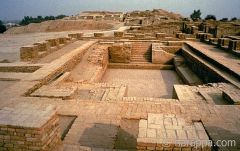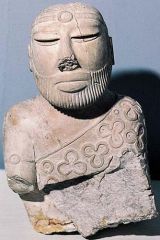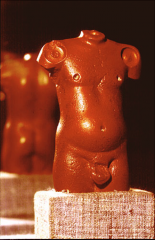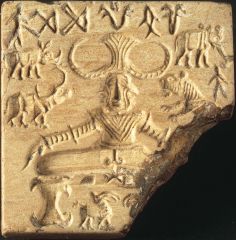![]()
![]()
![]()
Use LEFT and RIGHT arrow keys to navigate between flashcards;
Use UP and DOWN arrow keys to flip the card;
H to show hint;
A reads text to speech;
10 Cards in this Set
- Front
- Back
|
Buddha |
"The Enlightened one". An East Indian prince named Siddhartha Gautama, who renounced his wealth, family and social standing for an ascetic lifestyle to reach "enlightenment". |
|
|
Bodhi Tree |
Tree under which he meditated |
|
|
Four Noble Truths |
The core insights of Buddhism. Includes the Eightfold path. |
|

|
Title: The life and death of the Buddha Material: Schist rock |
|

|
-Stone frieze BUDDHA'S BIRTH BUDDHA'S ENLIGHTENMENT BUDDHA'S SERMON -Buddha teaching the Eightfold Path to nirvana in Deer Park at Sarnath |
|
|
Indus Civilization |
-South Asian civilization that flourished from 2600 to 1500 BCE -Most important sites: Mohenjo Daro and Harappa (present day Pakistan): fully developed cities, streets oriented to compass points, multi-storied houses of kiln baked bricks -TRADED - 1 OF THE WORLD'S SOPHISTICATED SYSTEMS OF WATER SUPPLY AND SEWAGE: private bathing areas, toilet facilities, drainage -no surviving bldg identified as temple or palace -all objects found are small |
|

|
THE GREAT BATH -at the heart of Mohenjo Daro -a complex of rooms with a brick pool in the center -probs for ritual bathing |
|

|
ROBED MALE FIGURE -Mohenjo Daro -Material: Steatite -Half closed eyes, low forehead, closely trimmed beard, shaved upper lip -Headband and armband with central circular emblem -Trefoils decorate his robe -Holes on each side of neck suggest he also wore a necklace of precious metal. Eyes, trefoils and circles originally held red paste and shell inlays. -Identity and rank uncertain but elaborate costume and precious materials make clear that he was an elite individual. |
|

|
NUDE MALE TORSO -red sandstone -highly polished surface -swelling curves of abdomen reveal interest in the fluid movement of the living body -pulsating vigor + emphasis on sensuous surfaces= characteristic of S Asian sculpture |
|

|
SEAL WITH SEATED FIGURE IN YOGIC POSTURE -Steatite seals with incised designs = most common Indus art objects -Similar to stamp seals of Mesopotamia - Most Indus seals= animal/tiny narrative carved on face with still-untranslated script -boss (circular knob) permitted insertion of string so the owner could wear/hang it -most represented animals (always strict profile): HUMPED BULL, ELEPHANT, RHINOCEROS, TIGER -Male figure w/ horned headdress, 3 faces and erect penis -Among animals in profile -Figures position suggest yogic posture = suggests imp meditative practice? |

